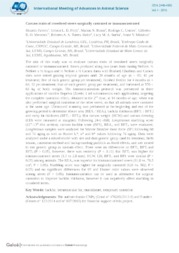Carcass traits of crossbred steers surgically castrated or immunocastrated.
Carcass traits of crossbred steers surgically castrated or immunocastrated.
Author(s): FAVERO, R.; FEIJO, G. L. D.; BONIN, M. N.; GOMES, R. da C.; MENEZES, G. R. de O.; TORRES JUNIOR, R. A. de A.; SURITA, L. M. A.; MIZUBUTI, I. Y.
Summary: The aim of this study was to evaluate carcass traits of crossbred steers surgically castrated or immunocastrated. Steers produced along two years from mating Nellore, 1/2 Nellore x 1/2 Angus and 1/2 Nellore x 1/2 Caracu dams with Braford, Charbray and Caracu sires were raised grazing tropical grasses until 20 months of age (n = 80; 40 per treatment; five of each genetic group per treatment), finished feedlot for 4 months (n = 64; 32 per treatment; four of each genetic group per treatment), and harvested at 570 ? 63 kg of body weight. The immunocastration protocol was performed in three applications of vaccine Bopriva (Zoetis; 1 ml subcutaneous each application), targeting the complete castration effect, obtained in the 2nd dose, at 14 months of age, when was also performed surgical castration of the other steers, so that all animals were castrated at the same age. Ultrasound scanning was performed at the beginning and end of the growing period to determine ribeye area (REAi / REAf), backfat thickness (BFTi / BFTf) and rump fat thickness (RFTi / RFTf). Hot carcass weight (HCW) and carcass dressing (CD) were measured at slaughter. Following 24-h chill, Longissimus marbling score (12th-13th ribs section), carcass backfat score (BFS), REAsl and BFTsl were evaluated. Longissimus samples were analyzed for Warner Bratzler shear force (SF) following 0d and 7d aging as well as Hunter L*, a* and b* values following 7d aging. Data were analyzed under a mixed model with sire and dam genetic group (and its iteration), birth season, castration method and backgrounding paddock as fixed effects, and sire nested in sire genetic group as random effect. There were no differences on BFTi, RFTi and RFTf (P > 0.05), however, there was tendency (P < 0.10) that BFTf was higher for immunocastrated steers (3.3 vs 2.8 mm). HCW, CD, BFTsl and BFS were similar (P > 0.05) among animals. The REAsl was superior for immunocastrated steers (81.8 vs. 76.5 cm2; P < 0.05). Marbling score was higher for surgically castrated (626 vs. 582; P < 0.05) and no significant differences for SF and Hunter color values were observed among steers (P > 0.05). Immunocastration can be used as alternative for surgical castration to improve backfat thickness, however it can negatively affect marbling in crossbred steers. - See more at: https://proceedings.galoa.com.br/imas/papers/carcass-traits-of-crossbred-steers-surgically-castrated-or-immunocastrated#sthash.wVsCYEpG.dpuf
Publication year: 2016
Types of publication: Abstract in annals or event proceedings
Unit: Embrapa Beef Cattle
Observation
Some of Embrapa's publications are published as ePub files. To read them, use or download one of the following free software options to your computer or mobile device. Android: Google Play Books; IOS: iBooks; Windows and Linux: Calibre.
Access other publications
Access the Agricultural Research Database (BDPA) to consult Embrapa's full library collection and records.
Visit Embrapa Bookstore to purchase books and other publications sold by Embrapa.

